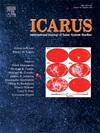行星尺度波在土卫六大气平流层超旋转中的作用
IF 2.5
2区 物理与天体物理
Q2 ASTRONOMY & ASTROPHYSICS
引用次数: 0
摘要
我们分析了泰坦wrf全球环流模式的模拟结果,以了解维持泰坦平流层赤道超旋转的机制。我们发现,与波浪活动有关的涡旋可以将角动量向上输送到纬向流,从而导致赤道超旋转的加速。本研究确定的主要波型与前人的研究一致,纬向波数1是推进加速的主要贡献者。尽管通过波-平均相互作用维持赤道超旋转的结论相同,但我们发现在泰坦wrf中波与纬向流相互作用的方式与其他研究略有不同。我们证实了我们之前的发现,在泰坦wrf中,这种情况主要发生在十几个每年一次的,短时间的(几个泰坦太阳)角动量“转移事件”中,这些事件具有可重复的季节性模式,但在时间和大小上略有不同。但泰坦大气模型(TAM)的情况并非如此,该模型发现,相对温和的角动量转移在平流层上层产生了最强烈的超旋转加速,在平流层下层产生了更连续的全年加速。尽管不同模式之间的角动量传递存在差异,但我们进一步发现,与TAM波分析结果类似,由罗斯比-开尔文不稳定性产生的涡流可能是赤道超旋转前进角动量的主要来源,尽管TitanWRF也可能包括垂直传播的赤道开尔文波的吸收。这与我们之前的研究不同,之前的研究认为正压波是造成泰坦wrf的至日转移事件的原因。本文章由计算机程序翻译,如有差异,请以英文原文为准。
The role of planetary-scale waves on the stratospheric superrotation in Titan's atmosphere
We analyze simulation results from the TitanWRF global circulation model to understand the mechanisms that maintain the equatorial superrotation in Titan's stratosphere. We find that the eddies associated with wave activities can transport angular momentum upgradient to zonal flow, leading to acceleration of the equatorial superrotation. The dominant wave modes identified in this study are consistent with previous studies, with zonal wavenumber 1 being the major contributor to the prograde acceleration. Despite the same conclusion of maintenance of equatorial superrotation via wave-mean interactions, we find that the way waves interact with the zonal flow in TitanWRF is slightly different from some other studies. We confirm our previous findings that in TitanWRF this occurs primarily during a dozen or so annual, short-duration (a few Titan sols) angular momentum “transfer events,” which have a repeatable seasonal pattern but differ slightly in timing and magnitude between years. This is not the case in the Titan Atmosphere Model (TAM), which found milder angular momentum transfers that produced the strongest acceleration of superrotation around solstice in the upper stratosphere and more continuous year-around acceleration in the lower stratosphere. Despite differences in angular momentum transfer across models, we further find that, similar to the TAM wave analysis results, eddies generated by Rossby-Kelvin instabilities may be the major source of prograde angular momentum for the equatorial superrotation, although TitanWRF may also include contributions from the absorption of vertically propagating equatorial Kelvin waves. This differs from our previous work, which suggested barotropic waves were responsible for TitanWRF's solsticial transfer event.
求助全文
通过发布文献求助,成功后即可免费获取论文全文。
去求助
来源期刊

Icarus
地学天文-天文与天体物理
CiteScore
6.30
自引率
18.80%
发文量
356
审稿时长
2-4 weeks
期刊介绍:
Icarus is devoted to the publication of original contributions in the field of Solar System studies. Manuscripts reporting the results of new research - observational, experimental, or theoretical - concerning the astronomy, geology, meteorology, physics, chemistry, biology, and other scientific aspects of our Solar System or extrasolar systems are welcome. The journal generally does not publish papers devoted exclusively to the Sun, the Earth, celestial mechanics, meteoritics, or astrophysics. Icarus does not publish papers that provide "improved" versions of Bode''s law, or other numerical relations, without a sound physical basis. Icarus does not publish meeting announcements or general notices. Reviews, historical papers, and manuscripts describing spacecraft instrumentation may be considered, but only with prior approval of the editor. An entire issue of the journal is occasionally devoted to a single subject, usually arising from a conference on the same topic. The language of publication is English. American or British usage is accepted, but not a mixture of these.
 求助内容:
求助内容: 应助结果提醒方式:
应助结果提醒方式:


